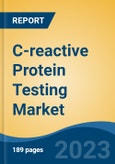Speak directly to the analyst to clarify any post sales queries you may have.
10% Free customizationThis report comes with 10% free customization, enabling you to add data that meets your specific business needs.
Healthcare professionals frequently use CRP testing to diagnose and monitor a broad range of conditions, including infectious diseases, autoimmune disorders, cardiovascular ailments, and post-surgical complications. Test results, reported in milligrams per liter (mg/L), provide valuable insight into the severity and progression of inflammation, supporting timely diagnosis and disease management strategies.
Key Market Drivers
Increasing Prevalence of Inflammatory and Infectious Diseases
A primary factor fueling market expansion is the growing global burden of inflammatory and infectious diseases. CRP testing is a critical diagnostic and prognostic tool used to detect and monitor a wide spectrum of conditions, including infections, autoimmune diseases, and cardiovascular disorders. As the incidence of these conditions rises globally, the demand for reliable inflammatory biomarkers like CRP continues to grow.CRP testing is particularly important in managing chronic inflammatory diseases such as rheumatoid arthritis (RA), inflammatory bowel disease (IBD), and lupus, as well as acute conditions like sepsis and pneumonia. It is estimated that 18 million individuals are affected by RA worldwide, with women comprising 70% of cases and over half of the affected population aged 55 or older. Notably, 13 million people suffer from moderate to severe RA, where early diagnosis and rehabilitation can significantly improve quality of life.
The rising prevalence of autoimmune and inflammatory conditions - driven by a combination of genetic, environmental, and lifestyle factors - has prompted broader adoption of CRP testing in routine clinical diagnostics.
Key Market Challenges
Lack of Specificity in Elevated CRP Levels
One of the key challenges limiting the market's full potential is the non-specific nature of elevated CRP levels. While CRP is a reliable marker of inflammation, it does not provide diagnostic specificity regarding the underlying cause. This ambiguity can complicate clinical decision-making, requiring additional tests to identify the root condition, thereby prolonging diagnosis and treatment initiation.Furthermore, due to its generalized nature, CRP testing is sometimes ordered inappropriately or excessively, particularly in cases where inflammation may not be clinically significant. This can lead to unnecessary healthcare spending and inefficient utilization of resources, contributing to diagnostic overuse and potential overdiagnosis.
Key Market Trends
Growing Emphasis on Personalized Medicine
The increasing focus on personalized medicine represents a transformative trend shaping the CRP testing market. Personalized medicine seeks to tailor medical treatment based on individual patient profiles, including genetic characteristics, lifestyle, and biomarker data. CRP serves as a critical biomarker for inflammation, enabling healthcare providers to design more targeted and effective treatment plans.CRP testing plays a pivotal role in risk assessment, particularly for cardiovascular diseases, where elevated CRP levels may signal higher risk and prompt preventive interventions tailored to an individual’s needs. It also supports continuous disease monitoring, allowing clinicians to track inflammation over time and make informed adjustments to treatment regimens based on changing CRP values.
Key Market Players
- Thermo Fisher Scientific, Inc.
- F. Hoffmann-La Roche Ltd.
- Danaher Corp
- Quest Diagnostics
- Siemens Healthineers AG
- Abbott Laboratories Inc.
- Merck KGaAA
- Zoetis Inc.
- Ortho Clinical Diagnostics
- Getein Biotech, Inc.
Report Scope:
In this report, the Global C-reactive Protein Testing Market has been segmented into the following categories, in addition to the industry trends which have also been detailed below:C-reactive Protein Testing Market, By Assay Type:
- Immunoturbidimetric Assay
- ELISA
- Chemiluminescence Immunoassay
- Others
C-reactive Protein Testing Market, By Detection Range:
- hs-CRP
- Conventional CRP
- cCRP
C-reactive Protein Testing Market, By Disease Area:
- Cardiovascular Diseases
- Cancer
- Rheumatoid Arthritis
- Inflammatory Bowel Disease
- Endometriosis
- Lupus
- Others
C-reactive Protein Testing Market, By End-User:
- Hospitals & Clinics
- Laboratories
- Assisted Living Healthcare Facilities
- Homecare
- Others
C-reactive Protein Testing Market, By region:
- North America
- United States
- Canada
- Mexico
- Asia-Pacific
- China
- India
- South Korea
- Australia
- Japan
- Europe
- Germany
- France
- United Kingdom
- Spain
- Italy
- South America
- Brazil
- Argentina
- Colombia
- Middle East & Africa
- South Africa
- Saudi Arabia
- UAE
Competitive Landscape
Company Profiles: Detailed analysis of the major companies present in the Global C-reactive Protein Testing Market.Available Customizations:
With the given market data, the publisher offers customizations according to a company's specific needs. The following customization options are available for the report.Company Information
- Detailed analysis and profiling of additional market players (up to five).
This product will be delivered within 1-3 business days.
Table of Contents
Companies Mentioned
- Thermo Fisher Scientific, Inc.
- F. Hoffmann-La Roche Ltd.
- Danaher Corp
- Quest Diagnostics
- Siemens Healthineers AG
- Abbott Laboratories Inc.
- Merck KGaAA
- Zoetis Inc.
- Ortho Clinical Diagnostics
- Getein Biotech, Inc.
Table Information
| Report Attribute | Details |
|---|---|
| No. of Pages | 185 |
| Published | April 2025 |
| Forecast Period | 2024 - 2030 |
| Estimated Market Value ( USD | $ 1.68 Billion |
| Forecasted Market Value ( USD | $ 1.9 Billion |
| Compound Annual Growth Rate | 2.1% |
| Regions Covered | Global |
| No. of Companies Mentioned | 10 |









